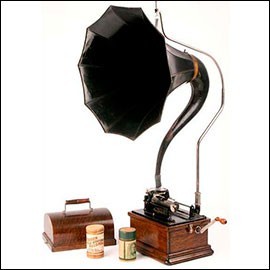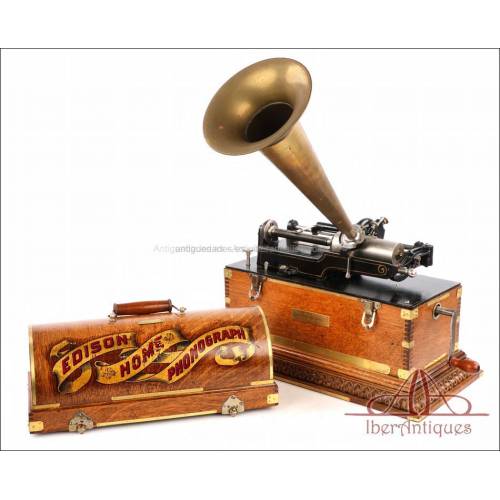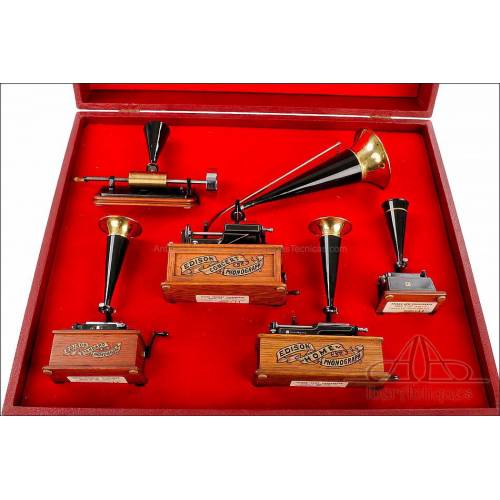Antique Phonographs
Antique phonographs were the first musical devices capable of reproducing sounds, previously recorded on wax cylinders. Their mechanism is very simple, but at the same time very resistant. Thanks to this feature, today there are phonographs more than 100 years old that are able to reproduce melodies recorded on vintage cylinders. The antique pho...
Antique phonographs were the first musical devices capable of reproducing sounds, previously recorded on wax cylinders. Their mechanism is very simple, but at the same time very resistant. Thanks to this feature, today there are phonographs more than 100 years old that are able to reproduce melodies recorded on vintage cylinders. The antique phonographs in our collection have been manufactured by the best brands of all times, including emblematic firms such as Edison or Columbia. These devices were manufactured from 1890 until 1920, when they were definitively replaced by gramophones.
History of early phonographs
The first phonograph in history was designed and built by Thomas A. Edison in 1877. It was undoubtedly one of the most important inventions of the 19th century: for the first time in history it was possible to record and reproduce sounds, from the human voice to the most complex musical performances. Initially, the first devices were not used to reproduce music, but to facilitate dictation work in offices. The first cylinders were made of metal, and the needle recorded the sounds directly on the foil; however, Alexander Graham Bell's laboratory developed more practical, cheaper and lighter wax-coated cardboard cylinders, which definitively replaced the metal ones. In 1888 the first gramophone was launched, and for 30 years both inventions coexisted and fought for the record market of the time. In the 1920s, gramophones definitively displaced the old phonographs; however, for a while the Edison firm continued to market a version called "dictaphone". This device was used in offices to record dictated texts. The cylinders could be re-recorded several times.
Features of early phonographs
These devices consist of several basic parts and a mechanically operated motor. The wooden box hides the motor inside, while in its upper part is the mechanism where the cylinder is placed. The horn is connected to the reproducer to amplify the sound. In old phonographs, the trumpet was usually removed in order to close the device with a wooden cover. The cover had a handle for carrying. As for the cylinders, those made of cardboard and wax usually offered a duration of 2 minutes; later they were replaced by celluloid cylinders with a duration of 4 minutes.
One of the most fascinating features of early phonographs is that the cylinders are always direct recordings of the original. These elements could not be reproduced mechanically, so they are all unique pieces.
Antique phonographs: reference brands
The first brand to manufacture and market phonographs was Thomas A. Edison. His models were imprinted with the name Edison Home Phonograph. However, it soon had an important competitor: the Columbia Phonograph Company. The French firm Pathé Frèrés, known for being one of the pioneers in the film industry (in the early twentieth century became the most important film producer in the world), also devoted a branch of its business to manufacture and market phonographs.
Antique phonographs are items full of history, ingenious design and great decorative potential. When we listen to music recorded on a cylinder in one of these devices, we are listening to an original vintage recording, unique and inimitable. For these reasons, they deserve a place of honor in any living room or collection.
Antique Edison Home Luxury Customized Phonograph, USA c. 1898 Antique Edison Home Luxury...
Edison Home phonograph c. 1898, customized with brass accents and a luxury base. Works perfectly and includes 7 Edison cylinders in excellent condition. Edison Home phonograph c. 1898,...
SoldDisplay Set of Edison Phonographs by Manuel Olivé Sans, 1977 Display Set of Edison...
Exclusive collection of 1:4 scale Edison phonographs, crafted by Manuel Olivé Sans in 1977. Limited edition, piece number 14 of 200, with original certificate and case. Exclusive collection of 1:4 scale...
Sold
New products
-

Antique ivory and silver plated stethoscope, late 19th century
Antique stethoscope from the late 19th century in silver-plated metal...
-

Vintage pendant with shell cameo of Jesús del Gran Poder, carved c. 1970
Vintage pendant with a shell-carved cameo of Jesus del Gran Poder, circa...
-

Antique Roman Style Gilded Silver Chalice with Paten. France, 1932
Antique Roman-style chalice in gilded silver with paten. France, 1932....
-

Beautiful Antique 18 K Gold Ring with 7 Natural Diamonds
Antique 18K gold ring with 7 natural diamonds. Delicate openwork design,...
-

Antique Silver Reliquary. José Vilaplana. Valencia, Spain. Circa 1920
Impressive repoussé silver reliquary by José Vilaplana, Valencia, c....
-

Vintage 18K Gold Ring with 7 Natural Diamonds
Vintage 18K gold ring with seven natural diamonds in floral setting....
-

Antique Silver Chalice. Enameled Crosses. Valencia, Spain, 1942
Spanish chalice from 1942 in solid silver, gifted by the Church of...
-

Antique Silver Chalice and Paten. Granada Spain, circa 1900
Spanish chalice in white silver with matching paten, handcrafted....
Specials
-

Antique Indian Mughal or Khanjar Dagger. Polychrome Carved Lion. Circa 1900
Gorgeous Indian Mughal or Khanjar...





